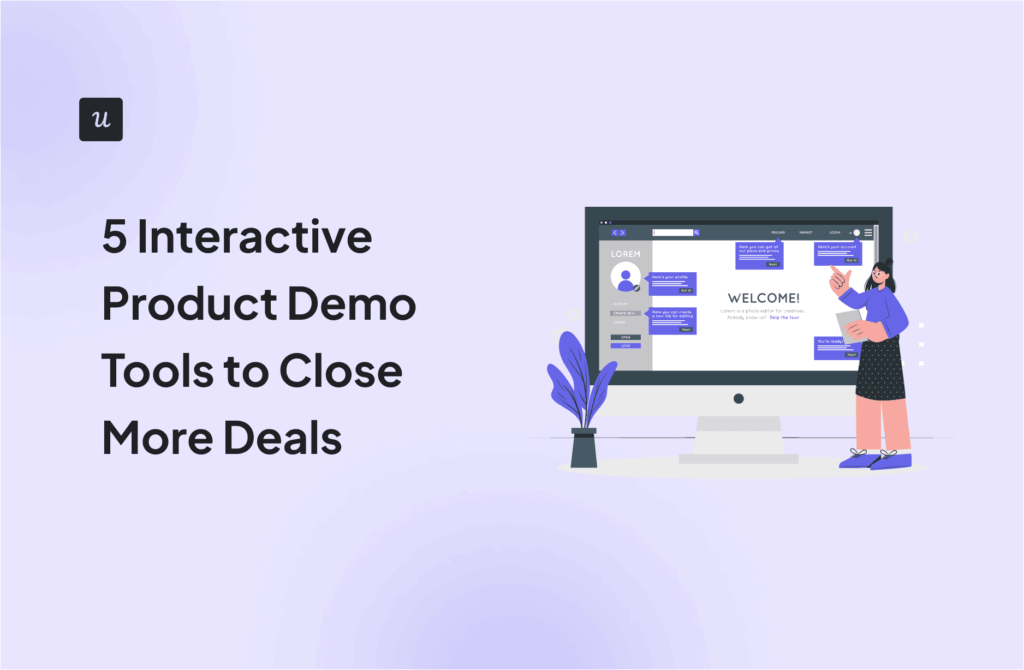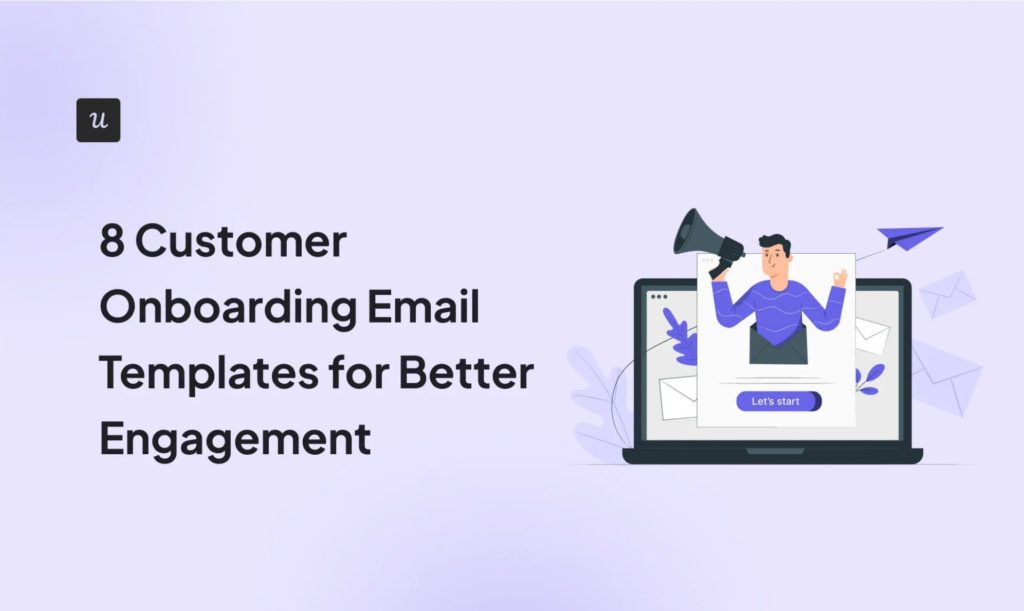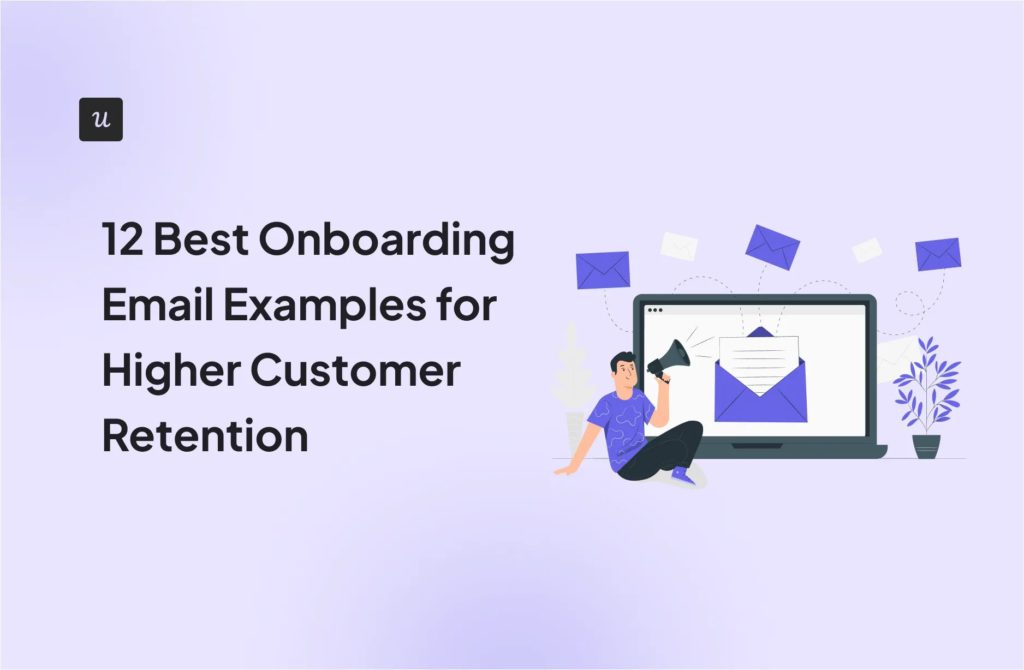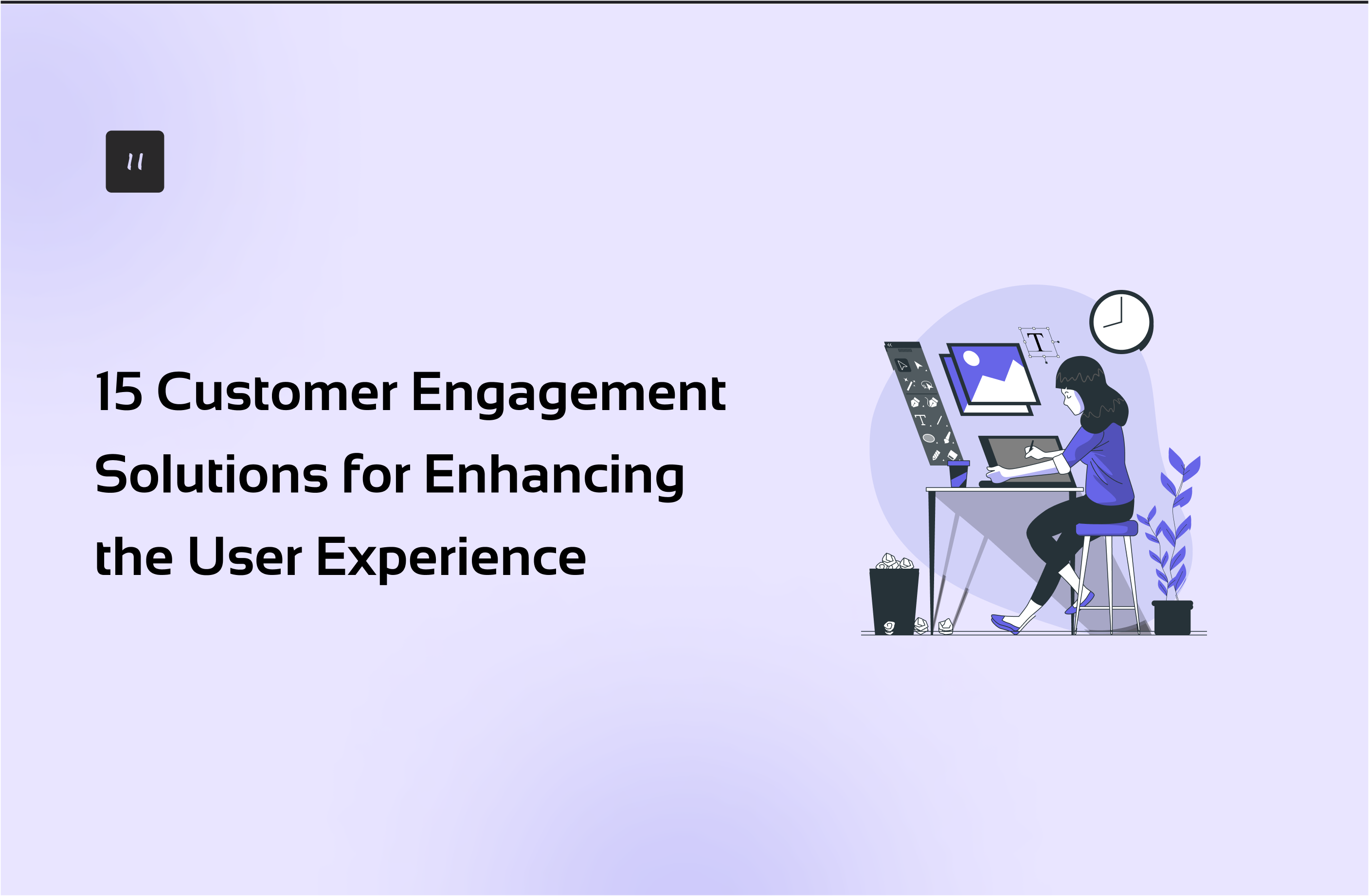
15 Customer Engagement Solutions for Enhancing the User Experience
What are the best customer engagement solutions for SaaS teams?
Short answers: depends on your needs and use cases.
In this article, we present 15 excellent customer engagement platforms that will help you engage your customers effectively at all stages of the user journey and across different channels.
Get The Insights!
The fastest way to learn about Product Growth, Management & Trends.
Summary of customer engagement solutions
- Zendesk is a customer service self-service platform with a comprehensive suite of tools including ticketing and live chat to enhance customer support and engagement via multiple channels.
- Typeform offers an intuitive platform for creating engaging surveys, perfect for collecting customer feedback.
- Mixpanel provides teams with detailed insights into how users interact with applications to help them make data-driven decisions.
- HubSpot, a popular CRM platform, supports businesses in managing customer interactions and data across marketing, sales, and service hubs.
- Appcues is recommended for user onboarding and engagement in mobile apps.
- Buffer is a social media management platform that allows teams to schedule posts and analyze their performance.
- ConvertKit is an email marketing tool that simplifies executing email onboarding and marketing campaigns.
- Hotjar is ideal for identifying friction in the customer journey with heatmaps and session recordings.
- Optimizely enables businesses to A/B test and personalize digital experiences to improve user engagement and conversion rates.
- Loom enhances communication with easy-to-make video messages, supporting marketing and customer success teams.
- Intercom offers chat-based communication tools for customer support and education.
- Discourse is a forum-based tool that fosters online discussions and community engagement.
- Gametize provides a platform for creating gamified experiences to aid customer training and engagement.
- Demio is a user-friendly software that simplifies hosting interactive webinars.
- Userpilot is an all-in-one customer engagement solution. It allows teams to design engaging onboarding experiences, provide in-app support, collect feedback, and analyze user behavior. Book the demo to find out more!
What is a customer engagement solution?
A customer engagement solution is a set of tools designed to help businesses interact with customers effectively across various touchpoints and channels, such as social media, email, chat, and in-app messaging.
These platforms enable businesses to deliver timely and relevant experiences, which enhance customer satisfaction and strengthen relationships.
Must-have features in customer engagement software
In addition to the core functionality for your specific use cases, here are a few features to look out for when choosing customer engagement tools:
- User segmentation – to personalize the user experience for customers with different use cases, needs, and pain points.
- Analytics and reporting – to analyze customer interactions with your product, assess the effectiveness of your engagement strategy, and identify ways to improve it.
- Automation – to reduce the number of tasks performed manually and reduce the pressure on your teams.
- Integrations – to seamlessly embed the tool into your workflows.
- Scalability and pricing – to ensure that the product can support your growing needs in the most cost-effective way.
15 best customer engagement software solutions worth trying
With all the basics out of the way, here’s our selection of the best customer engagement solutions available on the market.
| Platform | Purpose/Strength | Key Features | Pricing |
|---|---|---|---|
| Userpilot | All-in-one customer engagement solution | UI patterns, AI writing assistant, A/B testing, auto capture, analytics dashboards | Starter: $299/month, Growth: $799/month, Enterprise: Custom pricing |
| Zendesk | Customer service platform | Ticketing, live chat, knowledge base management, multi-channel communication | Team: $55/agent/month, Growth: $89/agent/month, Professional: $115/agent/month |
| Typeform | Customer feedback and survey creation | Intuitive form builder, multiple question types, feedback collection | Basic: $25/month, Plus: $50/month, Business: $83/month, Enterprise: Custom |
| Mixpanel | Customer behavior analytics | Flows, funnels, retention analysis, cohorts, impact analysis, experimentation analytics | Free, Growth: $20/month, Enterprise: $833/month |
| HubSpot | Customer relationship management (CRM) | Lead management, email tracking, customizable dashboards, marketing-sales integration | Free, Starter: $20/month, Professional: $1,600/month, Enterprise: $5,000/month |
| Appcues | User onboarding and engagement | In-app tours, feature announcements, surveys, mobile app support | Essentials: $249/month, Growth: $879/month, Enterprise: Custom pricing |
| Buffer | Social media management | AI assistant, post scheduling, analytics, engagement tools, content calendar | Free, Essentials: $6/month/channel, Team: $12/month/channel, Agency: $120/month/10 channels |
| ConvertKit | Email marketing automation | Automated sequences, subscriber segmentation, visual automation builder, analytics | Free, Creator: $9/month, Creator Pro: $25/month |
| Hotjar | UX and customer journey optimization | Heatmaps, session recordings, funnels, interview scheduling, dashboards | Free, Plus: $32/month, Business: $56/month |
| Optimizely | A/B testing and personalization | Experimentation, feature flagging, rollout management, personalization | Custom pricing (on request) |
| Loom | Video messaging | Video recording/sharing, editing tools, AI-powered silence removal, viewer insights, transcriptions | Starter: Free, Business: $12.50/user/month, Enterprise: Custom pricing |
| Intercom | Chat-based customer communication | Live chat, AI chatbot, automated messaging, knowledge base | Essential: $39/seat/month, Advanced: $99/seat/month, Expert: $139/seat/month |
| Discourse | Community discussion and management | Moderation tools, plugins and themes, community management | Basic: $50/month, Standard: $100/month, Business: $300/month, Enterprise: Custom |
| Gametize | Gamification for engagement | Challenges, rewards, leaderboards, social sharing | Light: $100/month, Regular: $200/month, Premium: $500/month, Enterprise: Custom |
| Demio | Interactive webinars | Live streaming, interactive tools, automated webinars, customizable registration | Starter: $42/month, Growth: $75/month, Premium: $184/month |
1. Userpilot – all-in-one customer engagement solution
Userpilot is a comprehensive user engagement solution for product, marketing, and customer success teams seeking to optimize the in-app user experience, drive product adoption, and account expansion.
Here’s a more detailed breakdown of Userpilot features:
- Different UI patterns: Use tooltips, modals, slideouts, onboarding checklists, banners, and hotspots to offer contextual support, announce updates, and engage users. The patterns can be triggered individually or as a part of multi-step interactive walkthroughs.
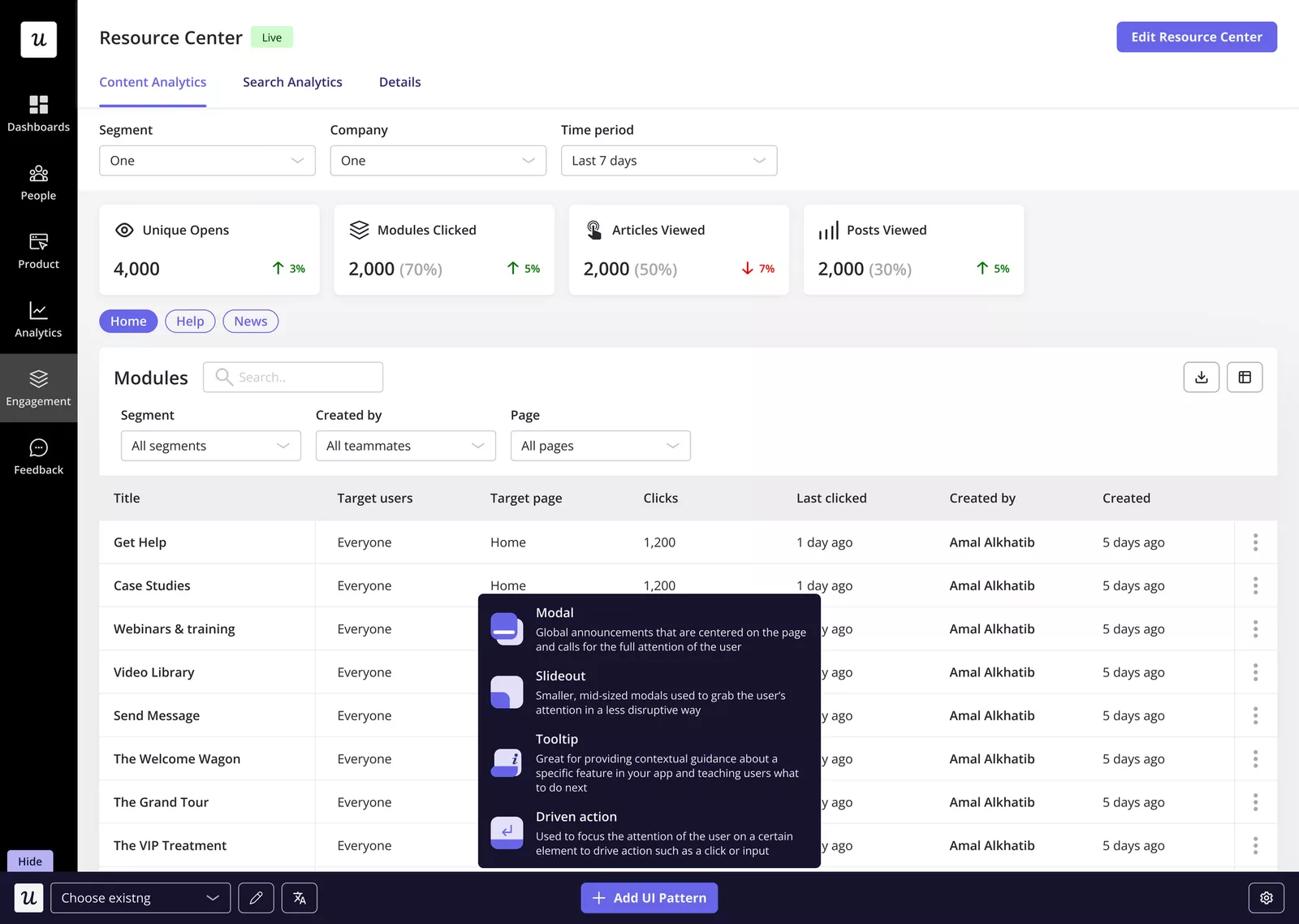
- AI writing assistant. Using our built-in AI writing assistant, you can refine your copy and find a version that resonates with users. You can ask AI to expand, shorten, or rephrase until it meets your expectations.
- A/B and multivariate testing. Userpilot enables you to run experiments using different variants of an in-app message to discover the variation that drives most conversions and optimize your flow around it.

- Auto capture: Record all important user interactions( including Clicks, Text input changes, and Form submissions) by default without manually tagging them. This allows you to analyze engagement with reports later and identify areas for improvement.
- Analytics dashboards: Visualize and track key customer engagement metrics like active users, feature adoption rate, and number of sessions at a glance.
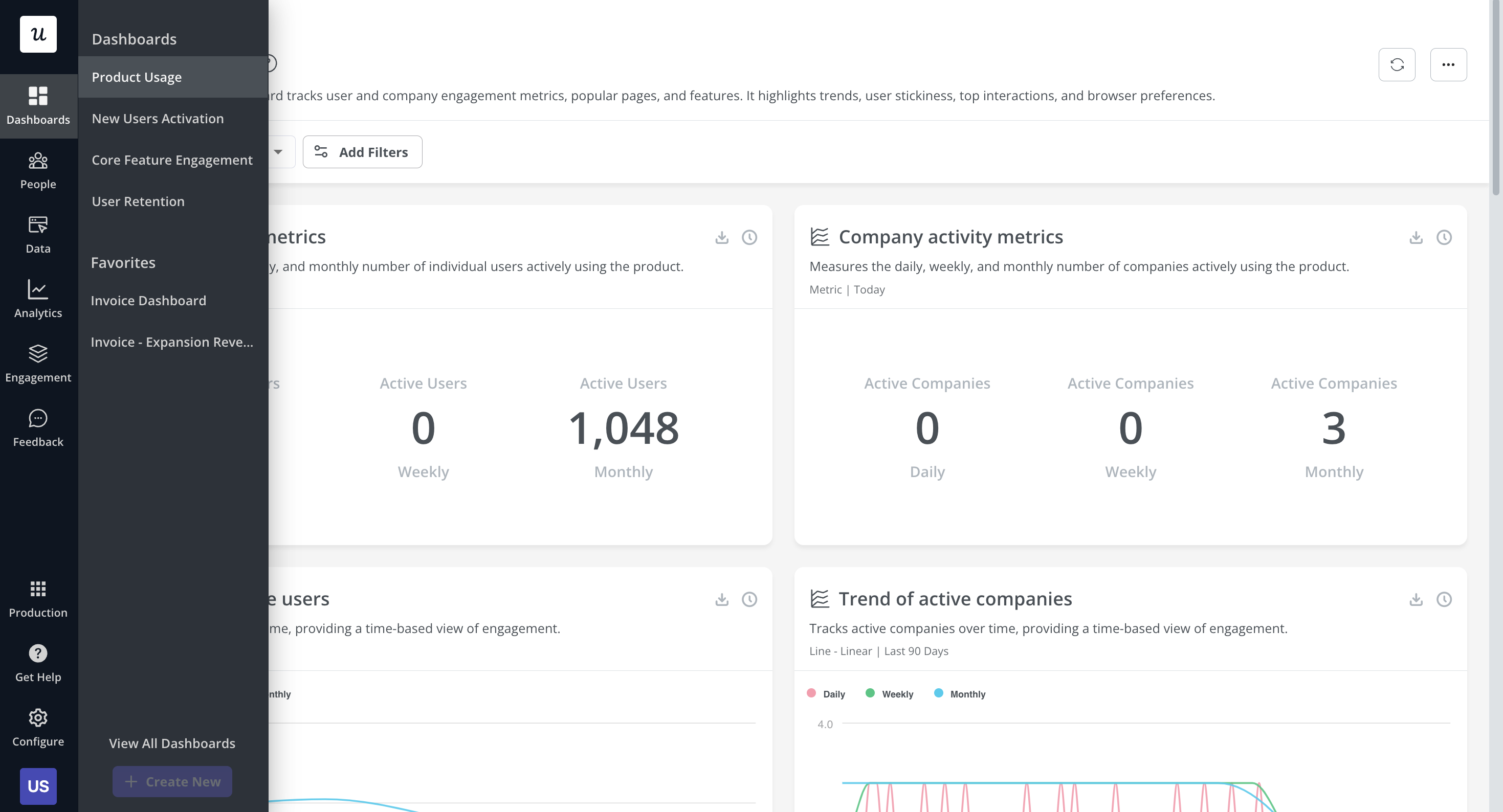
Userpilot pricing
Userpilot offers 3 pricing plans:
- Starter – from $299/month, billed annually.
- Growth – from $799/month, billed annually.
- Enterprise – custom pricing.
2. Zendesk – recommended customer service platform
Zendesk is a customer service platform that provides SaaS businesses with a range of tools to manage customer support and engagement.
The tool offers solutions for ticketing, customer support, help desk, live chat, and knowledge base management, among others.
The purpose of Zendesk is to improve communication with customers across multiple channels including email, phone, chat, and social media, and streamline customer service operations.

Zendesk pricing
Zendesk offers 4 plans:
- Team – from $55/agent/month
- Growth – from $89/agent/month
- Professional – from $115/agent/month
- Enterprise

3. Typeform – preferred tool for collecting customer satisfaction feedback
Typeform is a web-based solution for building forms and online surveys.
The platform allows users to create various types of forms, including surveys, quizzes, registration forms, and more, using a wide range of question types, including multiple-choice, short-answer, and Likert scales.
Product, marketing, and customer success teams can use Typeform to conduct customer research and collect customer satisfaction feedback.

Typeform pricing
Typeform has a 4-tier pricing structure:
- Basic – from $25/month
- Plus – from $50/month
- Business – from $83/month
- Enterprise – custom pricing

4. Mixpanel – recommended for analyzing customer behavior
Mixpanel is an advanced analytics platform that enables tracking user interactions with web and mobile applications.
It provides detailed insights into how users engage with an app, helping businesses understand user behavior, measure engagement, and make data-driven decisions to enhance their digital products.
Key Mixpanel reports include:
- Flows – to analyze all user interactions leading up to or following an event.
- Funnels – to track user progress and conversions at key stages in the user journey.
- Retention – to understand when users drop off and why.
- Cohorts/segments – to group users based on shared properties for more granular analysis.
- Impact analysis – to compare data from before and after a new feature launch.
- Signal – to identify correlations between data sets.

Mixpanel pricing
Mixpanel offers 3 pricing plans:
- Free
- Growth – from $20/month
- Enterprise – from $833/month

5. HubSpot – recommended customer relationship management tool
HubSpot is known for its powerful customer relationship management (CRM) platform, designed to help businesses manage and improve their interactions with customers and prospects.
Key features of HubSpot CRM include:
- Contact, lead, and deal management.
- Activity tracking – to automatically log customer interactions, including emails, calls, and social media engagements.
- Email integration and tracking – for sending emails directly within the platform and tracking email opens and clicks.
- Customizable reports and dashboards – with real-time insights into all your customer data, sales activities, marketing performance, and customer service metrics.
- Marketing and sales integration – the CRM enables seamless data flow between HubSpot’s Marketing Hub and Sales Hub and ensures there’s alignment between marketing and sales efforts.

HubSpot pricing
HubSpot offers 4 pricing plans, including a free one:
- Free
- Starter – from $20/month
- Professional – from $1,600/month
- Enterprise – from $5,000/month

6. Appcues – suggested onboarding tool for mobile apps
Appcues, just like Userpilot, is a product adoption platform. It enables companies to build and implement in-app onboarding tours, feature announcements, user surveys, and personalized messages without needing deep technical knowledge or coding.
Overall, its functionality is a bit limited when compared to Userpilot, but it has one advantage: it supports mobile apps.

Appcues pricing
There are 3 Appcues plans:
- Essentials – from $249 per month
- Growth – from $879 per month
- Enterprise – custom pricing

7. Buffer – recommended for managing social media communication channels
Buffer is a leading social media management software that allows marketing teams to maintain a consistent social media presence and engage with current and prospective customers.
Its main features include:
- Buffer AI Assistant – for content creation.
- Post scheduling.
- A dashboard for multiple social media account management.
- Analytics and reporting – to gather insights into post-performance.
- Content calendar – to easily view scheduled and published posts for better planning.
- Team management and collaboration – to better coordinate social media campaigns.
- Engagement tools – to monitor and respond to social media conversations, mentions, and messages.

Buffer pricing
In addition to the Free plan, buffer offers 3 paid ones:
- Essentials – $6/month for 1 channel
- Team – $12/month for 1 channel
- Agency – $120/month for 10 channels
You can save $60, $120, and $1,200 on the 3 plans respectively if you pay annually.

8. ConvertKit – preferred email marketing tool
ConvertKit is a powerful email marketing automation tool designed for creators and digital marketers to simplify creating and executing email campaigns and publishing newsletters.
Its main features include:
- Automated email sequences – to nurture leads and guide them through the customer journey.
- Subscriber tagging and segmentation – based on their behavior, preferences, and engagement, to run targeted and personalized email campaigns.
- Visual automation builder – with an intuitive drag-and-drop interface to easily design custom email workflows.
- Analytics and reporting – with detailed insights into campaign performance.

ConvertKit pricing
There are 3 ConverKit plans:
- Free
- Creator – from $9/month
- Creator Pro – from $25/month

9. Hotjar – recommended for spotting friction areas in the customer journey
Hotjar is a powerful analytics tool designed for UX designers, product managers, marketers, and researchers. It provides them with tools to identify usability issues and optimize the user experience by removing friction from the user journey.
Hotjar’s flagship features are session recordings and heatmaps. They allow teams to capture granular data about user interactions with product UI.
Its other features include:
- Custom dashboards.
- Funnels attached to session recordings for detailed analysis of the drop-off points.
- Automated interview scheduling and transcription.
- A pool of 200,000+ research participants from various walks of life all over the world.

Hotjar pricing
There are 3 Hotjar plans:
- Basic – free
- Plus – $32/month
- Business – $56/month

10. Optimizely – recommended for conducting A/B tests
Optimizely is a leading digital experience platform designed to help marketers, product managers, and developers improve user experience and increase conversion rates through experimentation.
Its key strength is robust A/B and multivariate testing capabilities. In addition, it supports:
- Personalization – you can customize experiences for different user segments based on their behavior, preferences, or demographics.
- Feature flagging and rollouts – it allows you to dark launch new features to a subset of users or control the visibility of features without deploying new code.
- Experimentation analytics – detailed insights and analytics helping teams understand the impact of changes and make informed decisions.

Optimizely pricing
Optimizely offers two packages, Web Experimentation and Feature Experimentation. The pricing for each is available on request.

11. Loom – preferred tool for creating and sharing videos
Loom is a video messaging tool that enables users to create and share video recordings with ease, facilitating efficient and personalized communications.
The tool is particularly useful for marketing and customer success teams who want to increase customer engagement, onboard users, and assist users with support messages, product tutorials, and quick high-touch responses to customer requests.
Main Loom features include:
- Easy video recording and sharing – via an automatically generated link.
- Video editing tools.
- AI-powered filler word and silence removal.
- Viewer insights – to track who has viewed their videos.
- Video transcriptions – to increase video accessibility and inclusivity.

Loom pricing
Loom comes with 3 plans:
- Starter – free
- Business – from $12.50/user/month
- Enterprise – custom price

12. Intercom – recommended live chat software
Intercom is a customer communication platform that enables businesses to manage customer interactions across the entire customer journey and foster strong relationships with customers via chat-based experiences.
Intercom’s main features include:
- Live chat – for real-time support on websites and mobile apps.
- AI chatbot – capable of qualifying leads, routing inquiries, and providing instant inquiries.
- Automated messaging – for sending targeted, automated messages based on user behavior or predefined triggers.
- Knowledge base – helping customers find answers to their questions through self-service, reducing the load on support teams.

Intercom pricing
Intercom users can choose from 3 plans:
- Essential – from $39/seat/month
- Advanced – from $99/seat/month
- Expert – from $139/seat/month

13. Discourse – recommended community management tool
Discourse is an open-source Internet forum and mailing list management software, designed to foster community discussions and engagement.
The platform provides a space for users to hold conversations in the form of posted messages, which you can then adapt for use as a discussion forum, a mailing list, or a chat room.
This makes it an ideal choice for building community forums and customer support hubs.
Its main features are:
- Moderation tools – to help maintain a healthy, respectful discussion environment.
- Plugins and themes – so that you can customize the platform to your specific needs and preferences.
- Community management – with features like trust levels, badges, and likes, you can encourage positive participation and help manage community dynamics.

Discourse pricing
There are 4 Discourse plans available:
- Basic – $50/month
- Standard – $100/month
- Business – $300/month
- Enterprise – available on request

14. Gametize – suggested tool to gamify the customer experience
Gametize is a gamification platform that allows businesses to create their own gamified experiences for user onboarding, training, marketing, and customer engagement.
What gamification strategies does Gametize use?
- Challenges – like quizzes, missions, and tasks, to engage their audience in a fun and interactive way.
- Rewards and badges – to incentivize users.
- Leaderboards – to foster a sense of competition among users.
- Social sharing – for users to share their achievements and progress on social media, expanding the reach and impact of the gamified experience.

Gametize pricing
Gametize offers 5 pricing plans:
- Light – from $100/month
- Regular – from $200/month
- Premium – from $500/month
- Premium Plus – from $1,000/month
- Enterprise – custom price

15. Demio – recommended webinar software to engage customers
Demio is a webinar platform built with educators and marketers in mind, and its main purpose is to simplify the process of hosting live interactive events online.
The tools boasts a clean and intuitive UI and a range of features that can be used to effectively engage audiences.
These include:
- High-quality live streaming – for hosting webinars, workshops, and presentations in real-time.
- Interactive tools – like polls, surveys, and Q&A sessions to engage the audience, gather feedback, and facilitate interaction during the webinar.
- Automated webinars – you can set up automated, pre-recorded webinars that run at scheduled times.
- Customizable registration pages – to capture attendee information and tailor the registration process.

Demio pricing
Companies can choose one of 3 plans:
- Starter – from $42/month
- Growth – from $75/month
- Premium – from $184/month

Conclusion
Here you are! Our selection of 15 best-in-class customer engagement solutions for SaaS teams.
Are they suitable for your SaaS? Hopefully, but not necessarily!
To make an informed decision, sign up for free trials and test them out. For complex products, like analytics platforms, start with a demo so that you know where to start when you first log in on your own.
On that note, is it fancy getting the Userpilot demo?



